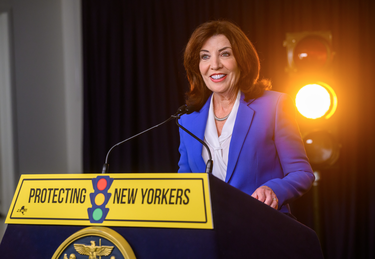More red lights will have cameras
— Photo by govkathyhochul
“Red light running at intersections with cameras has dropped 73 percent,” said Governor Kathy Hochul on Oct. 23 as she signed a bill that would extend the program, including in the city of Albany.
The city of Albany is having its red-light camera program extended.
Governor Kathy Hochul signed legislation on Oct. 23 to extend and expand the program started in 1994.
The legislation created a new program in the town of Greenburgh in Westchester County and expanded the program in New York City as well as extending the program in Albany and other municipalities.
“These cameras work to ensure drivers are slowing down and being more careful,” said Albany Mayor Kathy Sheehan in a release from the governor’s office. “Legislation like this helps us move toward keeping our roads safe for other drivers, pedestrians bicyclists, and those using alternative methods of transportation.”
During a signing ceremony, Hochul said that three decades of data on cameras in traffic lights show “they reduced crashes and they changed driver behavior.”
Since the program’s inception in New York City, Hochul said, “Red light running at intersections with cameras has dropped 73 percent. I don’t know what more you need than that data point. The T-bone crashes at intersections with cameras dropped 65 percent.”
She also said that last year, in New York City alone, “red light runners killed 29 of our friends, neighbors, and family members. All 29 incidents occurred at intersections without red light cameras.”
The number of red-light cameras in New York City is being quadrupled, from 150 to 600.
Hochul concluded of signing the red-light bill and another to increase fines for people repeatedly passing stopped school buses, “It’s part of a larger vision for an overall safer New York.”


